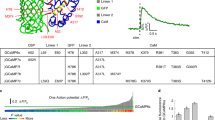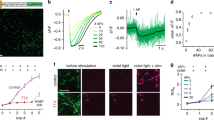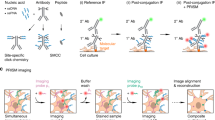Abstract
To build a quantitative model of molecular organization of neurons, it is essential to have information about the number of protein molecules at individual synapses. Here we developed a method to estimate absolute numbers of individual proteins at actual excitatory synapses by calibrating the fluorescence intensity of microspheres with single EGFP molecules. In cultured hippocampal neurons, we observed a monotonous increase of postsynaptic protein numbers per single synapse during neuronal differentiation and subsequent stabilization. At maturity we calculated that a single excitatory postsynaptic site contains 100–450 of individual postsynaptic proteins, such as PSD-95, GKAP, Shank and Homer. This narrow range of postsynaptic protein content suggests relatively simple stoichiometry of postsynaptic molecular organization. The EGFP-based calibration technique provides an unprecedented general method for estimating the amounts of proteins in macromolecular complexes.
This is a preview of subscription content, access via your institution
Access options
Subscribe to this journal
Receive 12 print issues and online access
$259.00 per year
only $21.58 per issue
Buy this article
- Purchase on Springer Link
- Instant access to full article PDF
Prices may be subject to local taxes which are calculated during checkout





Similar content being viewed by others
References
Palay, S.L. The morphology of synapses in the central nervous system. Exp. Cell Res. 5, 275–293 (1958).
Kennedy, M.B. Signal-processing machines at the postsynaptic density. Science 290, 750–754 (2000).
Sheng, M. & Kim, M.J. Postsynaptic signaling and plasticity mechanisms. Science 298, 776–780 (2002).
Kim, E. et al. GKAP, a novel synaptic protein that interacts with the guanylate kinase–like domain of the PSD-95/SAP90 family of channel clustering molecules. J. Cell Biol. 136, 669–678 (1997).
Naisbitt, S. et al. Shank, a novel family of postsynaptic density proteins that binds to the NMDA receptor/PSD-95/GKAP complex and cortactin. Neuron 23, 569–582 (1999).
Tadokoro, S., Tachibana, T., Imanaka, T., Nishida, W. & Sobue, K. Involvement of unique leucine-zipper motif of PSD-Zip45 (Homer1c/vesl-1L) in group 1 metabotropic glutamate receptor clustering. Proc. Natl. Acad. Sci. USA 96, 13801–13806 (1999).
Tu, J.C. et al. Homer binds a novel proline-rich motif and links group 1 metabotropic glutamate receptors with IP3 receptors. Neuron 21, 717–726 (1998).
Petersen, J.D. et al. Distribution of postsynaptic density (PSD)-95 and Ca2+/calmodulin-dependent protein kinase II at the PSD. J. Neurosci. 23, 11270–11278 (2003).
Valtschanoff, J.G. & Weinberg, R.J. Laminar organization of the NMDA receptor complex within the postsynaptic density. J. Neurosci. 21, 1211–1217 (2001).
Husi, H., Ward, M.A., Choudhary, J.S., Blackstock, W.P. & Grant, S.G. Proteomic analysis of NMDA receptor-adhesion protein signaling complexes. Nat. Neurosci. 3, 661–669 (2000).
Walikonis, R.S. et al. Identification of proteins in the postsynaptic density fraction by mass spectrometry. J. Neurosci. 20, 4069–4080 (2000).
Jordan, B.A. et al. Identification and verification of novel rodent postsynaptic density proteins. Mol. Cell. Proteomics 3, 857–871 (2004).
Tanaka, J. et al. Number and density of AMPA receptors in single synapses in immature cerebellum. J. Neurosci. 25, 799–807 (2005).
Nusser, Z. A new approach to estimate the number, density and variability of receptors at central synapses. Eur. J. Neurosci. 11, 745–752 (1999).
Jontes, J.D., Buchanan, J. & Smith, S.J. Growth cone and dendrite dynamics in zebrafish embryos: early events in synaptogenesis imaged in vivo. Nat. Neurosci. 3, 231–237 (2000).
Tokunaga, M., Kitamura, K., Saito, K., Iwane, A.H. & Yanagida, T. Single molecule imaging of fluorophores and enzymatic reactions achieved by objective-type total internal reflection fluorescence microscopy. Biochem. Biophys. Res. Commun. 235, 47–53 (1997).
Wu, X. et al. Immunofluorescent labeling of cancer marker Her2 and other cellular targets with semiconductor quantum dots. Nat. Biotechnol. 21, 41–46 (2003).
Iino, R., Koyama, I. & Kusumi, A. Single molecule imaging of green fluorescent proteins in living cells: E-cadherin forms oligomers on the free cell surface. Biophys. J. 80, 2667–2677 (2001).
Michalet, X. et al. Properties of fluorescent semiconductor nanocrystals and their application to biological labeling. Single Molecules 2, 261–276 (2001).
Kubitscheck, U., Kuckmann, O., Kues, T. & Peters, R. Imaging and tracking of single GFP molecules in solution. Biophys. J. 78, 2170–2179 (2000).
Patterson, G.H., Knobel, S.M., Sharif, W.D., Kain, S.R. & Piston, D.W. Use of the green fluorescent protein and its mutants in quantitative fluorescence microscopy. Biophys. J. 73, 2782–2790 (1997).
Muller, B.M. et al. SAP102, a novel postsynaptic protein that interacts with NMDA receptor complexes in vivo. Neuron 17, 255–265 (1996).
Muller, B.M. et al. Molecular characterization and spatial distribution of SAP97, a novel presynaptic protein homologous to SAP90 and the Drosophila discs-large tumor suppressor protein. J. Neurosci. 15, 2354–2366 (1995).
Kim, E., Cho, K.O., Rothschild, A. & Sheng, M. Heteromultimerization and NMDA receptor-clustering activity of Chapsyn-110, a member of the PSD-95 family of proteins. Neuron 17, 103–113 (1996).
Brenman, J.E., Christopherson, K.S., Craven, S.E., McGee, A.W. & Bredt, D.S. Cloning and characterization of postsynaptic density 93, a nitric oxide synthase interacting protein. J. Neurosci. 16, 7407–7415 (1996).
Usui, S. et al. Synaptic targeting of PSD-Zip45 (Homer 1c) and its involvement in the synaptic accumulation of F-actin. J. Biol. Chem. 278, 10619–10628 (2003).
Okabe, S., Urushido, T., Konno, D., Okado, H. & Sobue, K. Rapid redistribution of the postsynaptic density protein PSD-Zip45 (Homer 1c) and its differential regulation by NMDA receptors and calcium channels. J. Neurosci. 21, 9561–9571 (2001).
Okabe, S., Kim, H.D., Miwa, A., Kuriu, T. & Okado, H. Continual remodeling of postsynaptic density and its regulation by synaptic activity. Nat. Neurosci. 2, 804–811 (1999).
Chiu, C.S. et al. Number, density, and surface/cytoplasmic distribution of GABA transporters at presynaptic structures of knock-in mice carrying GABA transporter subtype 1-green fluorescent protein fusions. J. Neurosci. 22, 10251–10266 (2002).
Chiu, C.S., Kartalov, E., Unger, M., Quake, S. & Lester, H.A. Single-molecule measurements calibrate green fluorescent protein surface densities on transparent beads for use with 'knock-in' animals and other expression systems. J. Neurosci. Methods 105, 55–63 (2001).
Schikorski, T. & Stevens, C.F. Quantitative ultrastructural analysis of hippocampal excitatory synapses. J. Neurosci. 17, 5858–5867 (1997).
Racca, C., Stephenson, F.A., Streit, P., Roberts, J.D. & Somogyi, P. NMDA receptor content of synapses in stratum radiatum of the hippocampal CA1 area. J. Neurosci. 20, 2512–2522 (2000).
Shepherd, G.M. & Harris, K.M. Three-dimensional structure and composition of CA3 → CA1 axons in rat hippocampal slices: implications for presynaptic connectivity and compartmentalization. J. Neurosci. 18, 8300–8310 (1998).
Teruel, M.N., Blanpied, T.A., Shen, K., Augustine, G.J. & Meyer, T. A versatile microporation technique for the transfection of culture CNS neurons. J. Neurosci. Methods 93, 37–48 (1999).
Ebihara, T., Kawabata, I., Usui, S., Sobue, K. & Okabe, S. Synchronized formation and remodeling of postsynaptic densities: long-term visualization of hippocampal neurons expressing postsynaptic density proteins tagged with green fluorescent protein. J. Neurosci. 23, 2170–2181 (2003).
Acknowledgements
We thank M. Inui for PSD-95 antibody, T. Furuichi for pan-Homer antibody, T. Urushido for generating recombinant adenoviruses, A.M. Craig and R. Shigemoto for valuable advice. The work was supported by grants from the Ministry of Education, Culture, Sports, Science and Technology of Japan and Japan Science and Technology Corporation.
Author information
Authors and Affiliations
Corresponding author
Ethics declarations
Competing interests
The authors declare no competing financial interests.
Supplementary information
Supplementary Fig. 1
Relative affinity of monoclonal and polyclonal anti-GFP antibodies to EGFP or EYFP-tagged scaffolding proteins. (PDF 153 kb)
Supplementary Fig. 2
Relative immunoreactivity of PSD scaffolding proteins. (PDF 667 kb)
Supplementary Fig. 3
Spatial overlap of individual scaffolding protein clusters and their association with excitatory presynaptic structure. (PDF 508 kb)
Supplementary Fig. 4
Relative fluorescence intensity of PSD protein clusters with or without excitatory presynaptic structure. (PDF 97 kb)
Supplementary Fig. 5
Fluorescence intensity measurement of EGFP-Shank2 clusters before and after fixation. (PDF 308 kb)
Supplementary Fig. 6
Distribution of scaffolding protein content in single synapses determined by multiple antibodies. (PDF 130 kb)
Rights and permissions
About this article
Cite this article
Sugiyama, Y., Kawabata, I., Sobue, K. et al. Determination of absolute protein numbers in single synapses by a GFP-based calibration technique. Nat Methods 2, 677–684 (2005). https://doi.org/10.1038/nmeth783
Received:
Accepted:
Published:
Issue Date:
DOI: https://doi.org/10.1038/nmeth783
This article is cited by
-
O-GlcNAcylation modulates liquid–liquid phase separation of SynGAP/PSD-95
Nature Chemistry (2022)
-
Activity dependent dissociation of the Homer1 interactome
Scientific Reports (2022)
-
Imaging of spine synapses using super-resolution microscopy
Anatomical Science International (2021)
-
Enhancing neuronal chloride extrusion rescues α2/α3 GABAA-mediated analgesia in neuropathic pain
Nature Communications (2020)
-
Differential chloride homeostasis in the spinal dorsal horn locally shapes synaptic metaplasticity and modality-specific sensitization
Nature Communications (2020)



